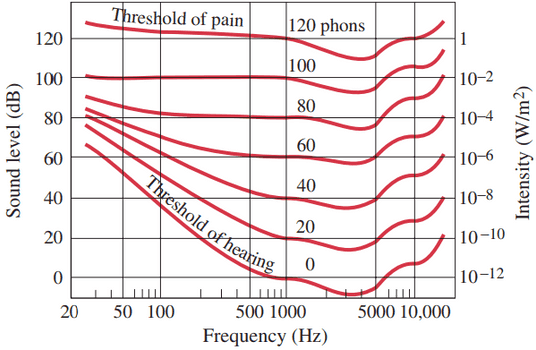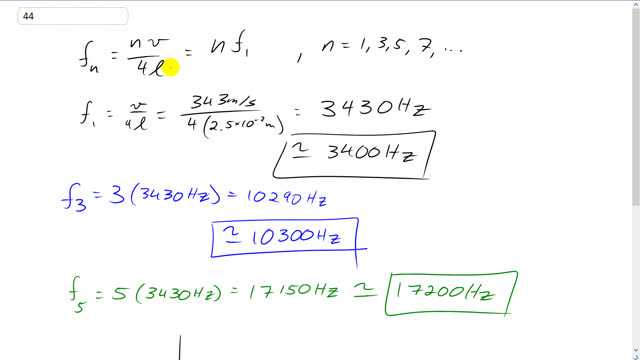
The human ear canal is approximately 2.5 cm long. It is open to the outside and is closed at the other end by the eardrum. Estimate the frequencies (in the audible range) of the standing waves in the ear canal. What is the relationship of your answer to the information in the graph of Fig. 12–6?


In order to watch this solution you need to have a subscription.
This is Giancoli Answers with Mr. Dychko. Modelled as a tube closed at one end, the ear canal will have these frequencies, n times the speed of sound divided by 4 times the length of the ear canal which is n times a fundamental frequency. And n is an odd integer, 1, 3, 5, 7 and so on. So, the fundamental frequency of the ear canal would be 343 meters per second divided by 4 times 2.5 times 10 to the minus 2 meters which is about 3,400 hertz. And the next harmonic will be f3 and that's 3 times 3,430 hertz which is about 10,300 hertz. And then the fifth harmonic is 5 times 30,430 hertz, which is 17200 hertz. And there are no harmonics in between these. So, if we look at this graph of perceived loudness versus frequency and versus sound level, it's basically like a 3 dimensional graph for each of these phons lines f1 designates a specific perceived loudness. So, this entire red line that I've tried to be drawn here is just one of the lines where every pair of sound level and frequencies corresponds to a single loudness. So, everything along this line is the same perceived loudness. Now, as you go down further down on this line it means that you need fewer and fewer decibels or a lower sound level for the same loudness. So, a frequency like right here say, this is the very, very very bottom of this red curve, is right here and that's about at 3,400 hertz. And that's because the ear canal itself resonates at that frequency as we figured out here that's the fundamental frequency of the ear canal. And so you need the fewest decibels, its lowest on the decibel scale to have the same perceived loudness of this frequency. Whereas, you know, just not too far from it up here at 5,000 hertz, you need more decibels to perceive it at the same volume, the same loudness, that's 3,400 hertz. And so as frequencies climb or get greater as you go to the right, so does the required sound level decibels in order to have the same perceived loudness except when you get to 10,000 hertz that trend appears to abate for a little while it sort of flatlines there for just a moment at about 10,000 hertz. And frequencies in this interval here don't need more and more decibels to get the same perceived loudness and presumably that's because that's the next harmonic, the next frequency which is resonating in the ear canal. There we go. Pretty interesting stuff.